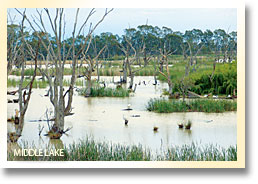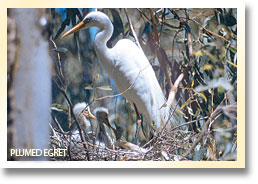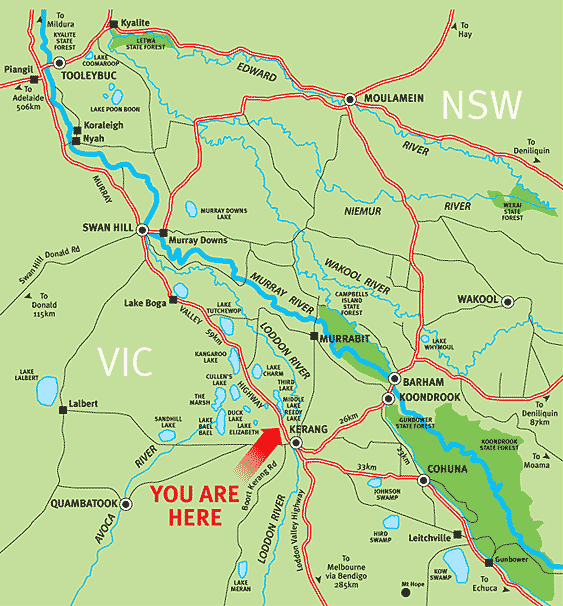
Middle Lake Ibis Rookery near Kerang, Victoria

|
The Ibis Rookery at Middle Lake, six kilometres north of Kerang is a popular destination for nature lovers and bird watchers. The bird hide offers viewers the perfect place to watch Strawnecked and White Ibis and other spectacular birds such as Pelicans, Swans, Spoonbills, Egrets and Ducks.
DistributionIbis can be found over most of Australia except for the inland of Western Australia. After breeding at Middle Lake, Ibis disperse widely. They are highly nomadic and can travel long distances. Some Ibis in Middle Lake had CSIRO bands placed on their legs, two of those bands were returned from New Guinea. Habitat
However, Straw-necked Ibis are also more likely to venture out into the dry country in search of food. From the bird hide in a good season you can see large colonies of Ibis nesting on islands of lignum and reeds, which have been bent over and trampled by the Ibis to form nests. The normal clutch of eggs consists of two to five eggs. Ibis can be seen rising on thermals high above the rookery, forming V formations to travel to the feeding areas, returning to feed the chicks with partly digested food. Ibis can travel 30 to 40 kilometres in search of food. Click here to learn more about Ibises Kerang | Lake Boga | Swan Hill (Down River) - Barham | Koondrook | Cohuna (Up River) Photographs by Tom Lowe
|
|||||||||||||||||||||||||
Tell your friends you found this at murrayriver.com.au!
Copyright Discover Murray 2025. This site or any portion of this site must not be reproduced, duplicated, copied, sold, resold, or otherwise exploited for any commercial purpose that is not expressly permitted by DISCOVER MURRAY.






 An Afternoon Of Classical Piano
An Afternoon Of Classical Piano CREEDENCE CLEARWATER COLLECTIVE
CREEDENCE CLEARWATER COLLECTIVE DREAMS FLEETWOOD MAC & STEVIE NICKS SHOW
DREAMS FLEETWOOD MAC & STEVIE NICKS SHOW Native Flower Showcase
Native Flower Showcase

 Two species of Ibis inhabit the rookery with numbers often exceeding 20,000. The White Ibis is identified by its almost entirely white body plumage. The Straw-necked Ibis has unique, yellow, straw-like feathers on its neck. The wings, back and collar are glossy, iridescent black while most of the underparts are white. In both species the head is featherless, with the skin black and a long, down-curved, black beak. The Royal Spoonbill with its black, spoon-shaped bill and black legs also nests in small numbers amongst the Ibis.
Two species of Ibis inhabit the rookery with numbers often exceeding 20,000. The White Ibis is identified by its almost entirely white body plumage. The Straw-necked Ibis has unique, yellow, straw-like feathers on its neck. The wings, back and collar are glossy, iridescent black while most of the underparts are white. In both species the head is featherless, with the skin black and a long, down-curved, black beak. The Royal Spoonbill with its black, spoon-shaped bill and black legs also nests in small numbers amongst the Ibis. Preferred habitats include shallow wetlands and open grasslands. In the Kerang area irrigated pasture attracts large numbers of Ibis feeding on crickets, grasshoppers, grubs and many insects flooded out by irrigation water. They are very effective pest controllers!
Preferred habitats include shallow wetlands and open grasslands. In the Kerang area irrigated pasture attracts large numbers of Ibis feeding on crickets, grasshoppers, grubs and many insects flooded out by irrigation water. They are very effective pest controllers!

